Analyzing Leadership in Health & Social Care Teams: A Case Study
VerifiedAdded on 2023/05/30
|22
|6152
|57
Case Study
AI Summary
This case study explores the role and importance of leadership in leading teams within health and social care settings, particularly focusing on improving home ratings. It examines various theoretical models such as Adair's Model of Action-centered Leadership, Transformational Theory, Contingency Theory, and Situational Leadership Theory, emphasizing their application in building successful health and social care teams. The study delves into motivating teams through stages of team development and encouraging open and effective communication. By analyzing the case of The Lawn Residential Care Home, the paper provides insights into how leadership strategies, team dynamics, and communication skills contribute to achieving desired goals and enhancing team performance in care settings. The importance of shared vision, mutual respect, and understanding individual roles within the team are highlighted, showcasing how effective leadership fosters a harmonious and supportive work environment. The case study also underscores the significance of adapting leadership styles to specific situations and promoting continuous development within the team to ensure the delivery of high-quality care.
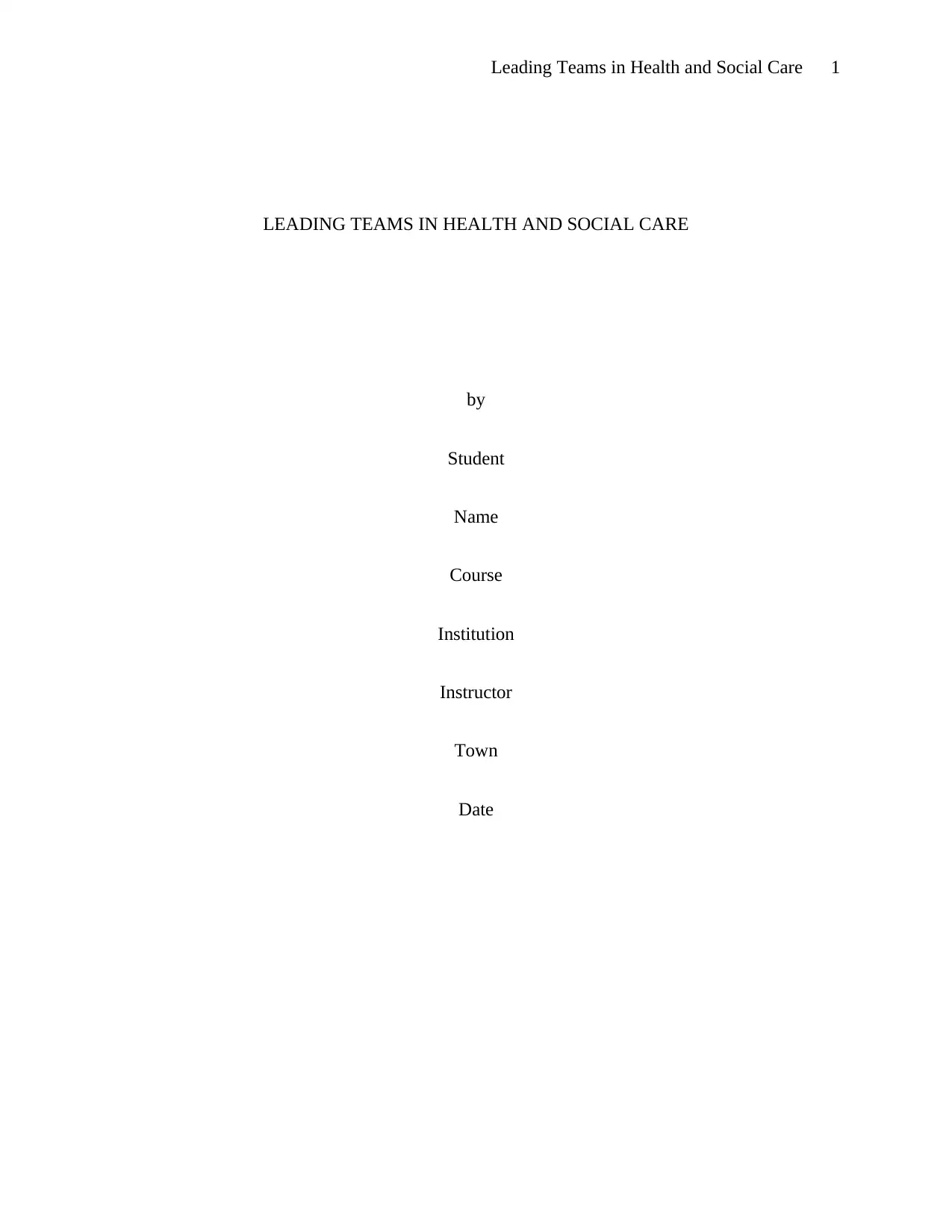
Leading Teams in Health and Social Care 1
LEADING TEAMS IN HEALTH AND SOCIAL CARE
by
Student
Name
Course
Institution
Instructor
Town
Date
LEADING TEAMS IN HEALTH AND SOCIAL CARE
by
Student
Name
Course
Institution
Instructor
Town
Date
Paraphrase This Document
Need a fresh take? Get an instant paraphrase of this document with our AI Paraphraser
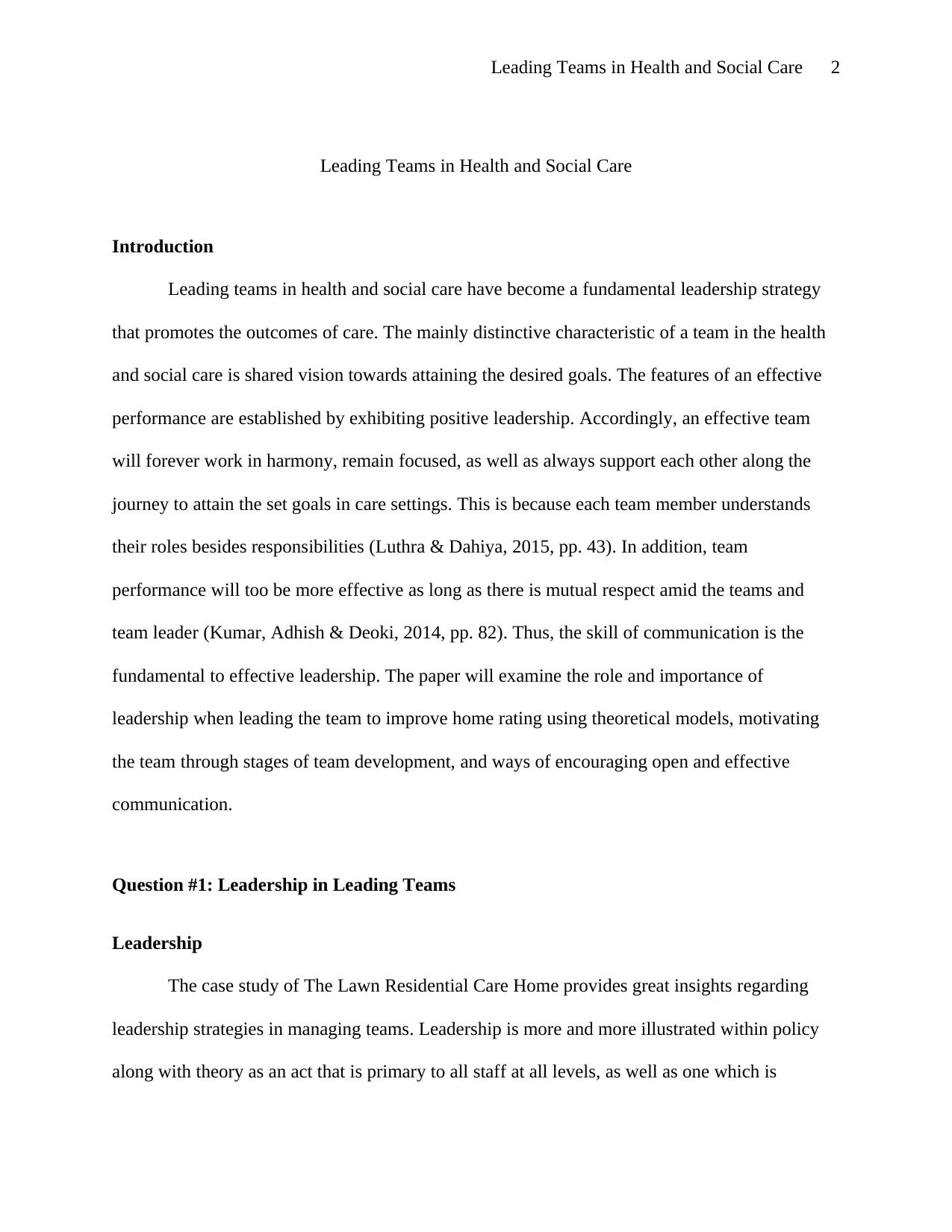
Leading Teams in Health and Social Care 2
Leading Teams in Health and Social Care
Introduction
Leading teams in health and social care have become a fundamental leadership strategy
that promotes the outcomes of care. The mainly distinctive characteristic of a team in the health
and social care is shared vision towards attaining the desired goals. The features of an effective
performance are established by exhibiting positive leadership. Accordingly, an effective team
will forever work in harmony, remain focused, as well as always support each other along the
journey to attain the set goals in care settings. This is because each team member understands
their roles besides responsibilities (Luthra & Dahiya, 2015, pp. 43). In addition, team
performance will too be more effective as long as there is mutual respect amid the teams and
team leader (Kumar, Adhish & Deoki, 2014, pp. 82). Thus, the skill of communication is the
fundamental to effective leadership. The paper will examine the role and importance of
leadership when leading the team to improve home rating using theoretical models, motivating
the team through stages of team development, and ways of encouraging open and effective
communication.
Question #1: Leadership in Leading Teams
Leadership
The case study of The Lawn Residential Care Home provides great insights regarding
leadership strategies in managing teams. Leadership is more and more illustrated within policy
along with theory as an act that is primary to all staff at all levels, as well as one which is
Leading Teams in Health and Social Care
Introduction
Leading teams in health and social care have become a fundamental leadership strategy
that promotes the outcomes of care. The mainly distinctive characteristic of a team in the health
and social care is shared vision towards attaining the desired goals. The features of an effective
performance are established by exhibiting positive leadership. Accordingly, an effective team
will forever work in harmony, remain focused, as well as always support each other along the
journey to attain the set goals in care settings. This is because each team member understands
their roles besides responsibilities (Luthra & Dahiya, 2015, pp. 43). In addition, team
performance will too be more effective as long as there is mutual respect amid the teams and
team leader (Kumar, Adhish & Deoki, 2014, pp. 82). Thus, the skill of communication is the
fundamental to effective leadership. The paper will examine the role and importance of
leadership when leading the team to improve home rating using theoretical models, motivating
the team through stages of team development, and ways of encouraging open and effective
communication.
Question #1: Leadership in Leading Teams
Leadership
The case study of The Lawn Residential Care Home provides great insights regarding
leadership strategies in managing teams. Leadership is more and more illustrated within policy
along with theory as an act that is primary to all staff at all levels, as well as one which is
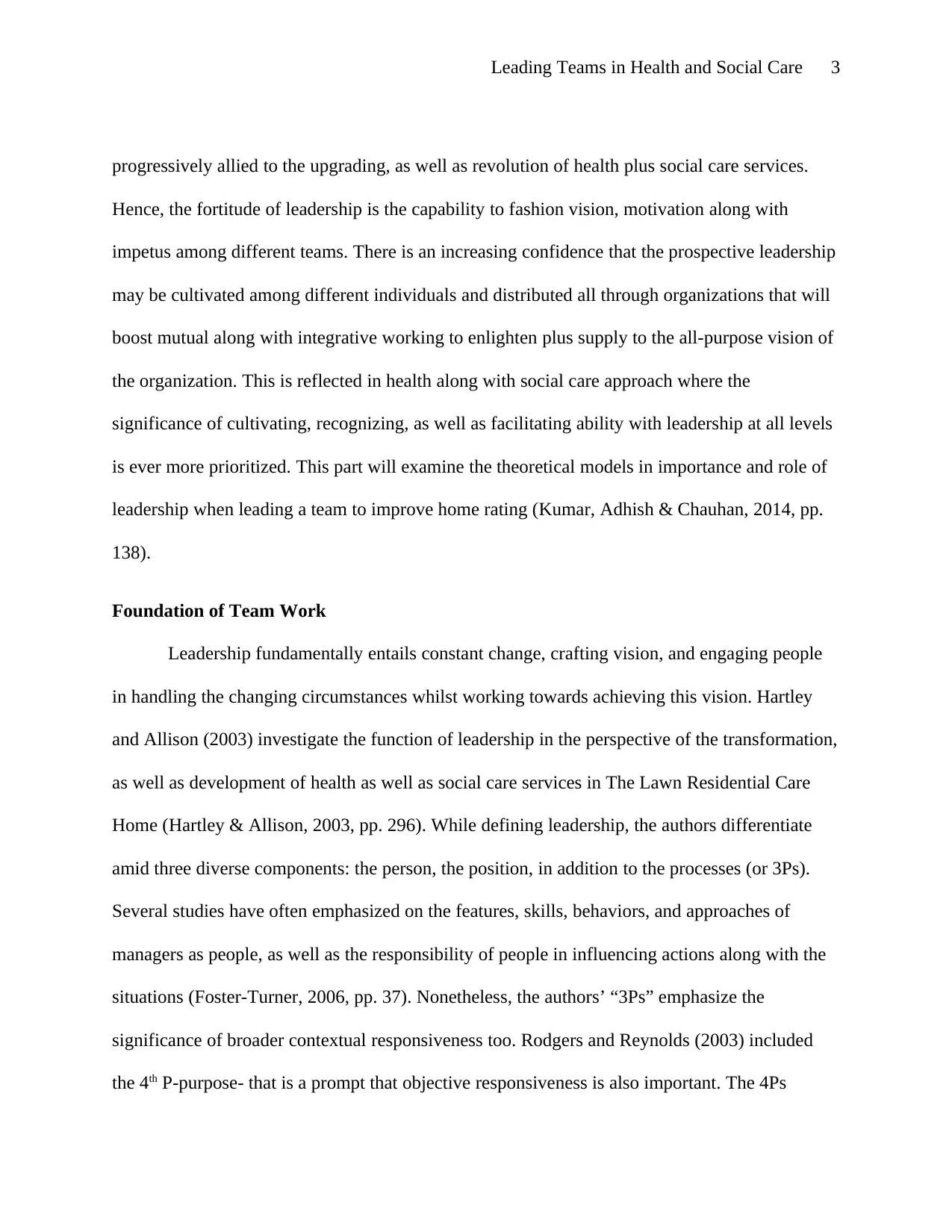
Leading Teams in Health and Social Care 3
progressively allied to the upgrading, as well as revolution of health plus social care services.
Hence, the fortitude of leadership is the capability to fashion vision, motivation along with
impetus among different teams. There is an increasing confidence that the prospective leadership
may be cultivated among different individuals and distributed all through organizations that will
boost mutual along with integrative working to enlighten plus supply to the all-purpose vision of
the organization. This is reflected in health along with social care approach where the
significance of cultivating, recognizing, as well as facilitating ability with leadership at all levels
is ever more prioritized. This part will examine the theoretical models in importance and role of
leadership when leading a team to improve home rating (Kumar, Adhish & Chauhan, 2014, pp.
138).
Foundation of Team Work
Leadership fundamentally entails constant change, crafting vision, and engaging people
in handling the changing circumstances whilst working towards achieving this vision. Hartley
and Allison (2003) investigate the function of leadership in the perspective of the transformation,
as well as development of health as well as social care services in The Lawn Residential Care
Home (Hartley & Allison, 2003, pp. 296). While defining leadership, the authors differentiate
amid three diverse components: the person, the position, in addition to the processes (or 3Ps).
Several studies have often emphasized on the features, skills, behaviors, and approaches of
managers as people, as well as the responsibility of people in influencing actions along with the
situations (Foster-Turner, 2006, pp. 37). Nonetheless, the authors’ “3Ps” emphasize the
significance of broader contextual responsiveness too. Rodgers and Reynolds (2003) included
the 4th P-purpose- that is a prompt that objective responsiveness is also important. The 4Ps
progressively allied to the upgrading, as well as revolution of health plus social care services.
Hence, the fortitude of leadership is the capability to fashion vision, motivation along with
impetus among different teams. There is an increasing confidence that the prospective leadership
may be cultivated among different individuals and distributed all through organizations that will
boost mutual along with integrative working to enlighten plus supply to the all-purpose vision of
the organization. This is reflected in health along with social care approach where the
significance of cultivating, recognizing, as well as facilitating ability with leadership at all levels
is ever more prioritized. This part will examine the theoretical models in importance and role of
leadership when leading a team to improve home rating (Kumar, Adhish & Chauhan, 2014, pp.
138).
Foundation of Team Work
Leadership fundamentally entails constant change, crafting vision, and engaging people
in handling the changing circumstances whilst working towards achieving this vision. Hartley
and Allison (2003) investigate the function of leadership in the perspective of the transformation,
as well as development of health as well as social care services in The Lawn Residential Care
Home (Hartley & Allison, 2003, pp. 296). While defining leadership, the authors differentiate
amid three diverse components: the person, the position, in addition to the processes (or 3Ps).
Several studies have often emphasized on the features, skills, behaviors, and approaches of
managers as people, as well as the responsibility of people in influencing actions along with the
situations (Foster-Turner, 2006, pp. 37). Nonetheless, the authors’ “3Ps” emphasize the
significance of broader contextual responsiveness too. Rodgers and Reynolds (2003) included
the 4th P-purpose- that is a prompt that objective responsiveness is also important. The 4Ps
⊘ This is a preview!⊘
Do you want full access?
Subscribe today to unlock all pages.

Trusted by 1+ million students worldwide
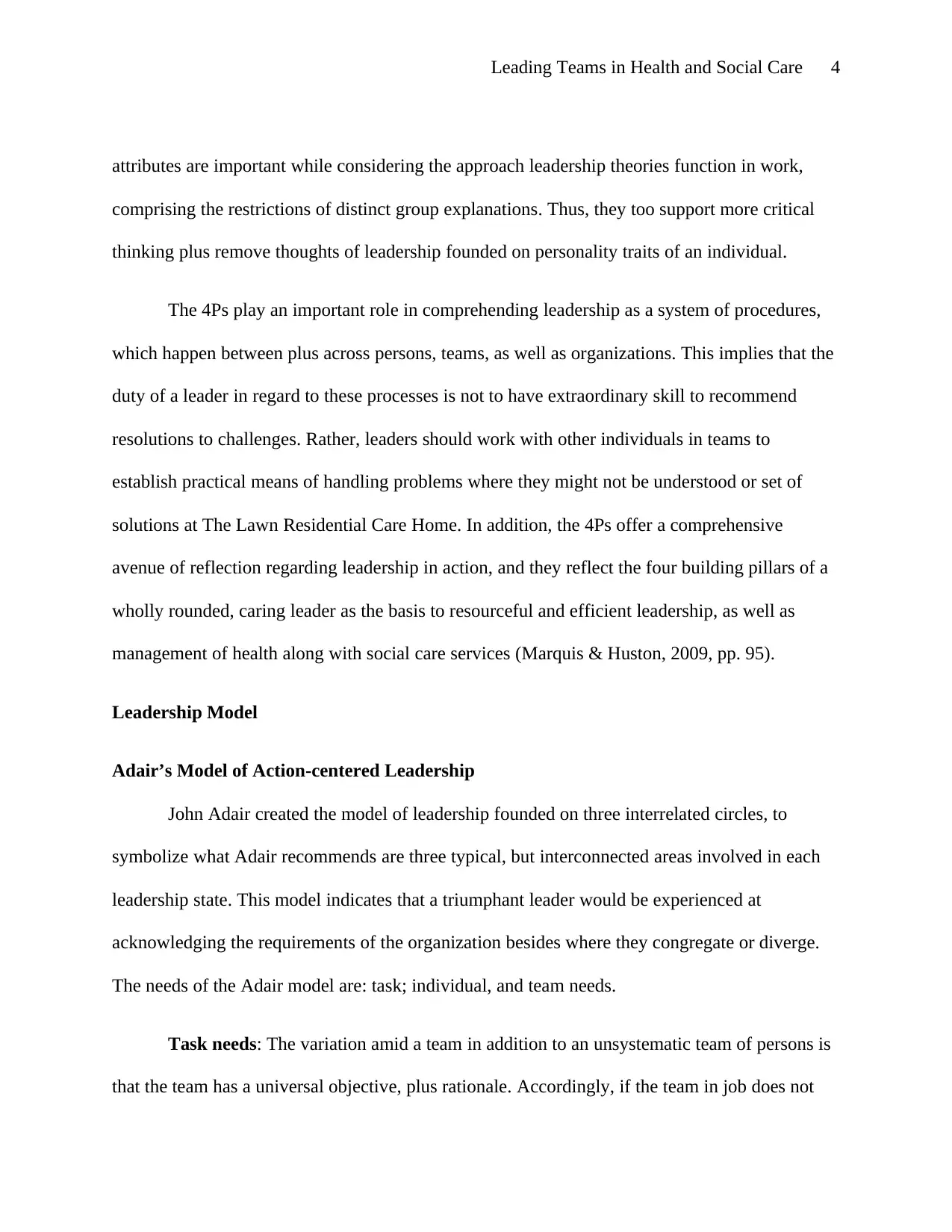
Leading Teams in Health and Social Care 4
attributes are important while considering the approach leadership theories function in work,
comprising the restrictions of distinct group explanations. Thus, they too support more critical
thinking plus remove thoughts of leadership founded on personality traits of an individual.
The 4Ps play an important role in comprehending leadership as a system of procedures,
which happen between plus across persons, teams, as well as organizations. This implies that the
duty of a leader in regard to these processes is not to have extraordinary skill to recommend
resolutions to challenges. Rather, leaders should work with other individuals in teams to
establish practical means of handling problems where they might not be understood or set of
solutions at The Lawn Residential Care Home. In addition, the 4Ps offer a comprehensive
avenue of reflection regarding leadership in action, and they reflect the four building pillars of a
wholly rounded, caring leader as the basis to resourceful and efficient leadership, as well as
management of health along with social care services (Marquis & Huston, 2009, pp. 95).
Leadership Model
Adair’s Model of Action-centered Leadership
John Adair created the model of leadership founded on three interrelated circles, to
symbolize what Adair recommends are three typical, but interconnected areas involved in each
leadership state. This model indicates that a triumphant leader would be experienced at
acknowledging the requirements of the organization besides where they congregate or diverge.
The needs of the Adair model are: task; individual, and team needs.
Task needs: The variation amid a team in addition to an unsystematic team of persons is
that the team has a universal objective, plus rationale. Accordingly, if the team in job does not
attributes are important while considering the approach leadership theories function in work,
comprising the restrictions of distinct group explanations. Thus, they too support more critical
thinking plus remove thoughts of leadership founded on personality traits of an individual.
The 4Ps play an important role in comprehending leadership as a system of procedures,
which happen between plus across persons, teams, as well as organizations. This implies that the
duty of a leader in regard to these processes is not to have extraordinary skill to recommend
resolutions to challenges. Rather, leaders should work with other individuals in teams to
establish practical means of handling problems where they might not be understood or set of
solutions at The Lawn Residential Care Home. In addition, the 4Ps offer a comprehensive
avenue of reflection regarding leadership in action, and they reflect the four building pillars of a
wholly rounded, caring leader as the basis to resourceful and efficient leadership, as well as
management of health along with social care services (Marquis & Huston, 2009, pp. 95).
Leadership Model
Adair’s Model of Action-centered Leadership
John Adair created the model of leadership founded on three interrelated circles, to
symbolize what Adair recommends are three typical, but interconnected areas involved in each
leadership state. This model indicates that a triumphant leader would be experienced at
acknowledging the requirements of the organization besides where they congregate or diverge.
The needs of the Adair model are: task; individual, and team needs.
Task needs: The variation amid a team in addition to an unsystematic team of persons is
that the team has a universal objective, plus rationale. Accordingly, if the team in job does not
Paraphrase This Document
Need a fresh take? Get an instant paraphrase of this document with our AI Paraphraser
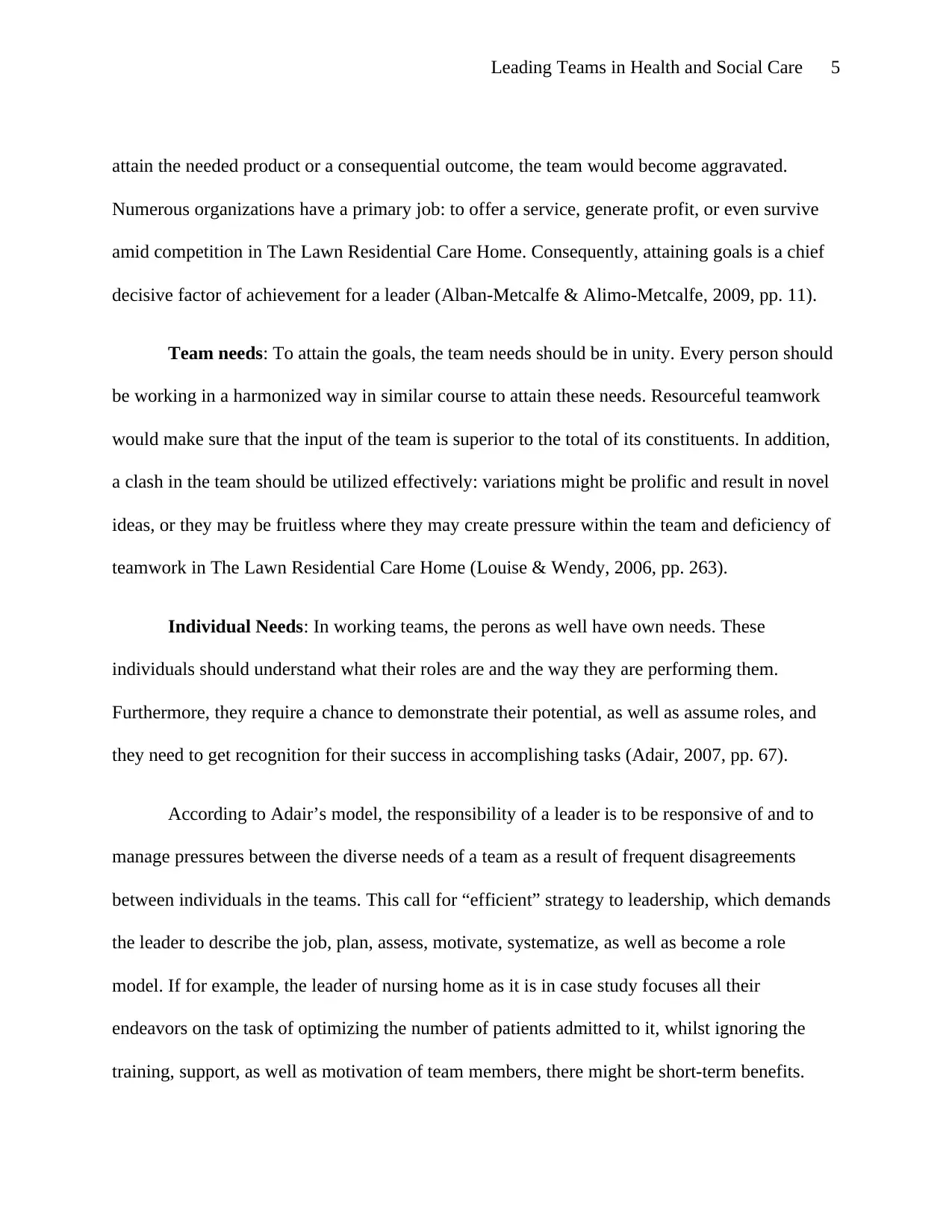
Leading Teams in Health and Social Care 5
attain the needed product or a consequential outcome, the team would become aggravated.
Numerous organizations have a primary job: to offer a service, generate profit, or even survive
amid competition in The Lawn Residential Care Home. Consequently, attaining goals is a chief
decisive factor of achievement for a leader (Alban-Metcalfe & Alimo-Metcalfe, 2009, pp. 11).
Team needs: To attain the goals, the team needs should be in unity. Every person should
be working in a harmonized way in similar course to attain these needs. Resourceful teamwork
would make sure that the input of the team is superior to the total of its constituents. In addition,
a clash in the team should be utilized effectively: variations might be prolific and result in novel
ideas, or they may be fruitless where they may create pressure within the team and deficiency of
teamwork in The Lawn Residential Care Home (Louise & Wendy, 2006, pp. 263).
Individual Needs: In working teams, the perons as well have own needs. These
individuals should understand what their roles are and the way they are performing them.
Furthermore, they require a chance to demonstrate their potential, as well as assume roles, and
they need to get recognition for their success in accomplishing tasks (Adair, 2007, pp. 67).
According to Adair’s model, the responsibility of a leader is to be responsive of and to
manage pressures between the diverse needs of a team as a result of frequent disagreements
between individuals in the teams. This call for “efficient” strategy to leadership, which demands
the leader to describe the job, plan, assess, motivate, systematize, as well as become a role
model. If for example, the leader of nursing home as it is in case study focuses all their
endeavors on the task of optimizing the number of patients admitted to it, whilst ignoring the
training, support, as well as motivation of team members, there might be short-term benefits.
attain the needed product or a consequential outcome, the team would become aggravated.
Numerous organizations have a primary job: to offer a service, generate profit, or even survive
amid competition in The Lawn Residential Care Home. Consequently, attaining goals is a chief
decisive factor of achievement for a leader (Alban-Metcalfe & Alimo-Metcalfe, 2009, pp. 11).
Team needs: To attain the goals, the team needs should be in unity. Every person should
be working in a harmonized way in similar course to attain these needs. Resourceful teamwork
would make sure that the input of the team is superior to the total of its constituents. In addition,
a clash in the team should be utilized effectively: variations might be prolific and result in novel
ideas, or they may be fruitless where they may create pressure within the team and deficiency of
teamwork in The Lawn Residential Care Home (Louise & Wendy, 2006, pp. 263).
Individual Needs: In working teams, the perons as well have own needs. These
individuals should understand what their roles are and the way they are performing them.
Furthermore, they require a chance to demonstrate their potential, as well as assume roles, and
they need to get recognition for their success in accomplishing tasks (Adair, 2007, pp. 67).
According to Adair’s model, the responsibility of a leader is to be responsive of and to
manage pressures between the diverse needs of a team as a result of frequent disagreements
between individuals in the teams. This call for “efficient” strategy to leadership, which demands
the leader to describe the job, plan, assess, motivate, systematize, as well as become a role
model. If for example, the leader of nursing home as it is in case study focuses all their
endeavors on the task of optimizing the number of patients admitted to it, whilst ignoring the
training, support, as well as motivation of team members, there might be short-term benefits.
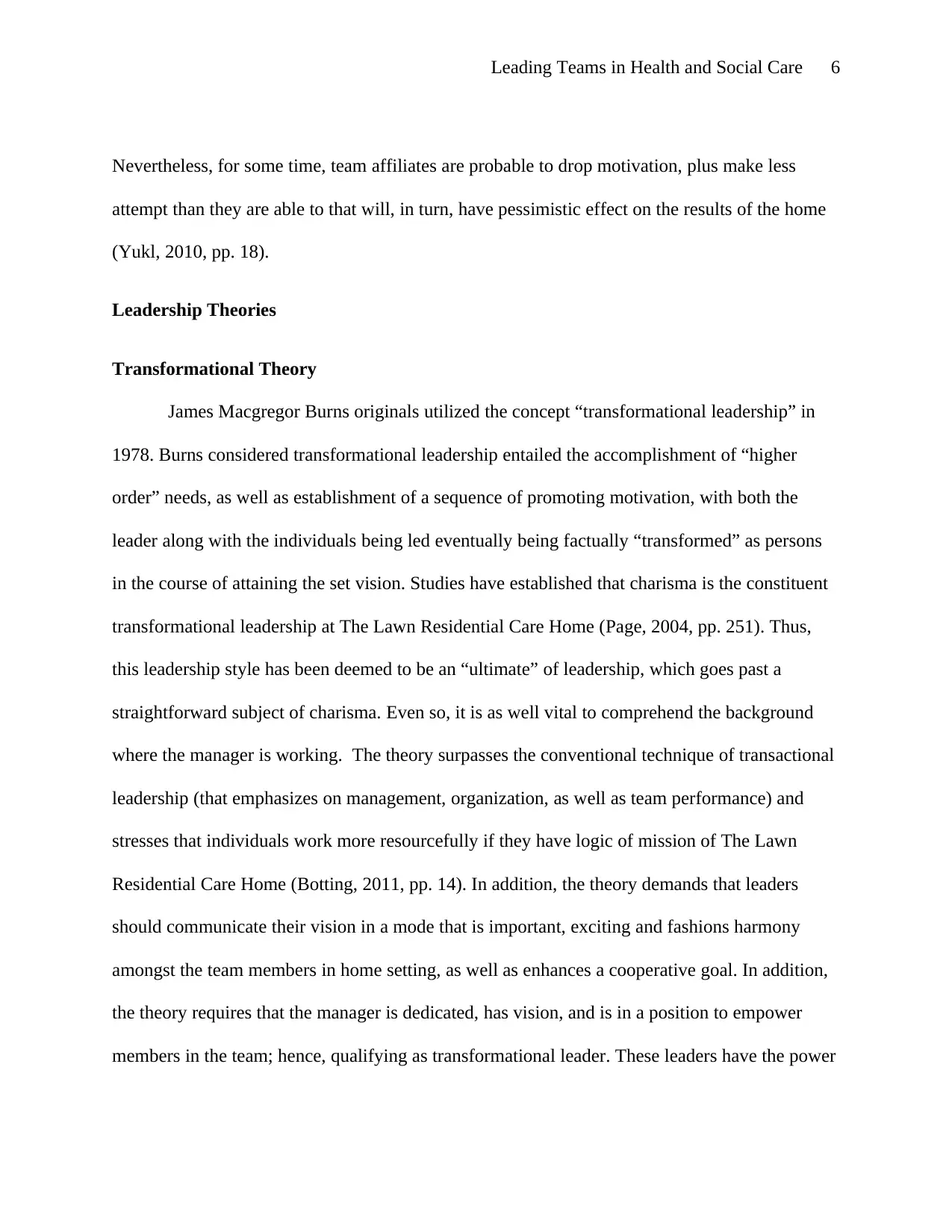
Leading Teams in Health and Social Care 6
Nevertheless, for some time, team affiliates are probable to drop motivation, plus make less
attempt than they are able to that will, in turn, have pessimistic effect on the results of the home
(Yukl, 2010, pp. 18).
Leadership Theories
Transformational Theory
James Macgregor Burns originals utilized the concept “transformational leadership” in
1978. Burns considered transformational leadership entailed the accomplishment of “higher
order” needs, as well as establishment of a sequence of promoting motivation, with both the
leader along with the individuals being led eventually being factually “transformed” as persons
in the course of attaining the set vision. Studies have established that charisma is the constituent
transformational leadership at The Lawn Residential Care Home (Page, 2004, pp. 251). Thus,
this leadership style has been deemed to be an “ultimate” of leadership, which goes past a
straightforward subject of charisma. Even so, it is as well vital to comprehend the background
where the manager is working. The theory surpasses the conventional technique of transactional
leadership (that emphasizes on management, organization, as well as team performance) and
stresses that individuals work more resourcefully if they have logic of mission of The Lawn
Residential Care Home (Botting, 2011, pp. 14). In addition, the theory demands that leaders
should communicate their vision in a mode that is important, exciting and fashions harmony
amongst the team members in home setting, as well as enhances a cooperative goal. In addition,
the theory requires that the manager is dedicated, has vision, and is in a position to empower
members in the team; hence, qualifying as transformational leader. These leaders have the power
Nevertheless, for some time, team affiliates are probable to drop motivation, plus make less
attempt than they are able to that will, in turn, have pessimistic effect on the results of the home
(Yukl, 2010, pp. 18).
Leadership Theories
Transformational Theory
James Macgregor Burns originals utilized the concept “transformational leadership” in
1978. Burns considered transformational leadership entailed the accomplishment of “higher
order” needs, as well as establishment of a sequence of promoting motivation, with both the
leader along with the individuals being led eventually being factually “transformed” as persons
in the course of attaining the set vision. Studies have established that charisma is the constituent
transformational leadership at The Lawn Residential Care Home (Page, 2004, pp. 251). Thus,
this leadership style has been deemed to be an “ultimate” of leadership, which goes past a
straightforward subject of charisma. Even so, it is as well vital to comprehend the background
where the manager is working. The theory surpasses the conventional technique of transactional
leadership (that emphasizes on management, organization, as well as team performance) and
stresses that individuals work more resourcefully if they have logic of mission of The Lawn
Residential Care Home (Botting, 2011, pp. 14). In addition, the theory demands that leaders
should communicate their vision in a mode that is important, exciting and fashions harmony
amongst the team members in home setting, as well as enhances a cooperative goal. In addition,
the theory requires that the manager is dedicated, has vision, and is in a position to empower
members in the team; hence, qualifying as transformational leader. These leaders have the power
⊘ This is a preview!⊘
Do you want full access?
Subscribe today to unlock all pages.

Trusted by 1+ million students worldwide
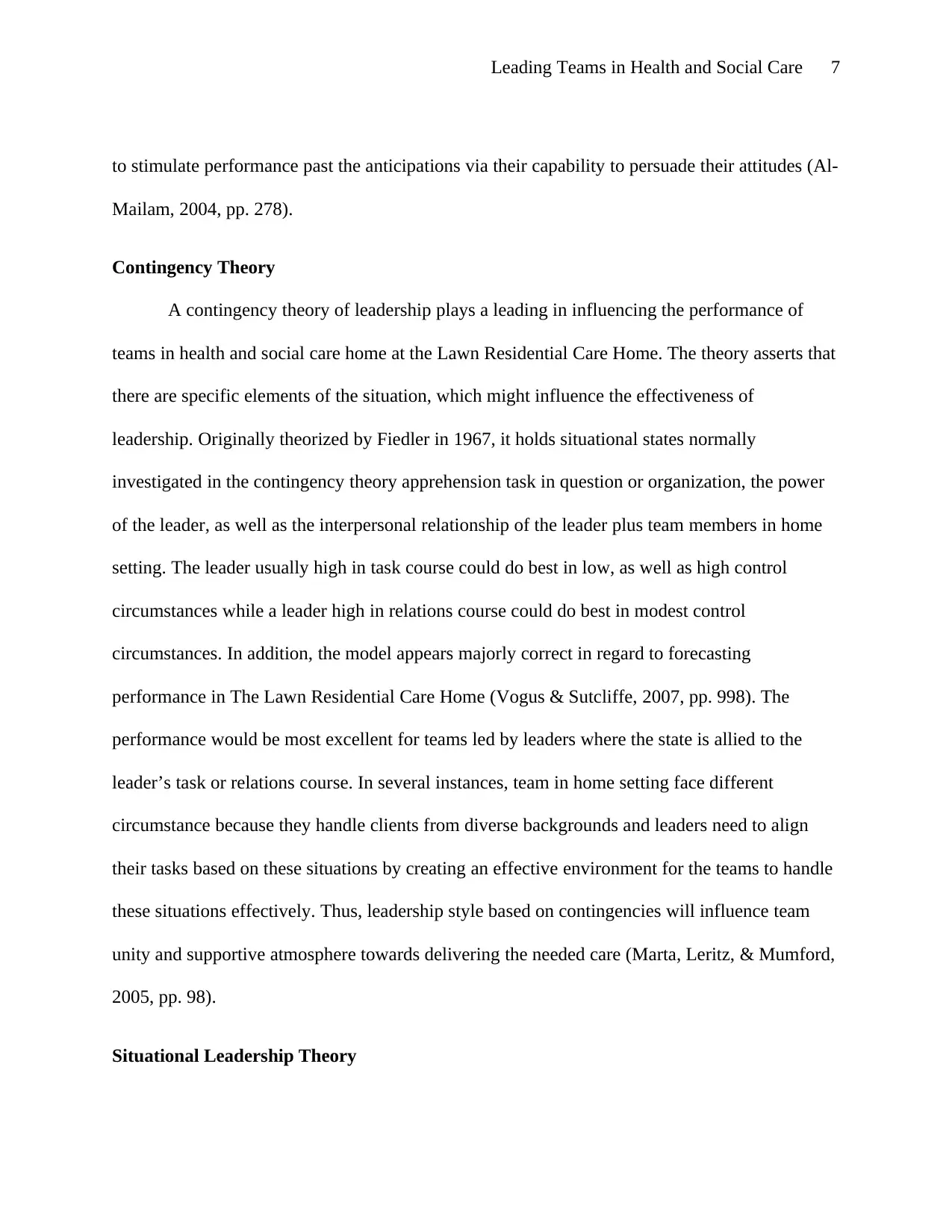
Leading Teams in Health and Social Care 7
to stimulate performance past the anticipations via their capability to persuade their attitudes (Al-
Mailam, 2004, pp. 278).
Contingency Theory
A contingency theory of leadership plays a leading in influencing the performance of
teams in health and social care home at the Lawn Residential Care Home. The theory asserts that
there are specific elements of the situation, which might influence the effectiveness of
leadership. Originally theorized by Fiedler in 1967, it holds situational states normally
investigated in the contingency theory apprehension task in question or organization, the power
of the leader, as well as the interpersonal relationship of the leader plus team members in home
setting. The leader usually high in task course could do best in low, as well as high control
circumstances while a leader high in relations course could do best in modest control
circumstances. In addition, the model appears majorly correct in regard to forecasting
performance in The Lawn Residential Care Home (Vogus & Sutcliffe, 2007, pp. 998). The
performance would be most excellent for teams led by leaders where the state is allied to the
leader’s task or relations course. In several instances, team in home setting face different
circumstance because they handle clients from diverse backgrounds and leaders need to align
their tasks based on these situations by creating an effective environment for the teams to handle
these situations effectively. Thus, leadership style based on contingencies will influence team
unity and supportive atmosphere towards delivering the needed care (Marta, Leritz, & Mumford,
2005, pp. 98).
Situational Leadership Theory
to stimulate performance past the anticipations via their capability to persuade their attitudes (Al-
Mailam, 2004, pp. 278).
Contingency Theory
A contingency theory of leadership plays a leading in influencing the performance of
teams in health and social care home at the Lawn Residential Care Home. The theory asserts that
there are specific elements of the situation, which might influence the effectiveness of
leadership. Originally theorized by Fiedler in 1967, it holds situational states normally
investigated in the contingency theory apprehension task in question or organization, the power
of the leader, as well as the interpersonal relationship of the leader plus team members in home
setting. The leader usually high in task course could do best in low, as well as high control
circumstances while a leader high in relations course could do best in modest control
circumstances. In addition, the model appears majorly correct in regard to forecasting
performance in The Lawn Residential Care Home (Vogus & Sutcliffe, 2007, pp. 998). The
performance would be most excellent for teams led by leaders where the state is allied to the
leader’s task or relations course. In several instances, team in home setting face different
circumstance because they handle clients from diverse backgrounds and leaders need to align
their tasks based on these situations by creating an effective environment for the teams to handle
these situations effectively. Thus, leadership style based on contingencies will influence team
unity and supportive atmosphere towards delivering the needed care (Marta, Leritz, & Mumford,
2005, pp. 98).
Situational Leadership Theory
Paraphrase This Document
Need a fresh take? Get an instant paraphrase of this document with our AI Paraphraser
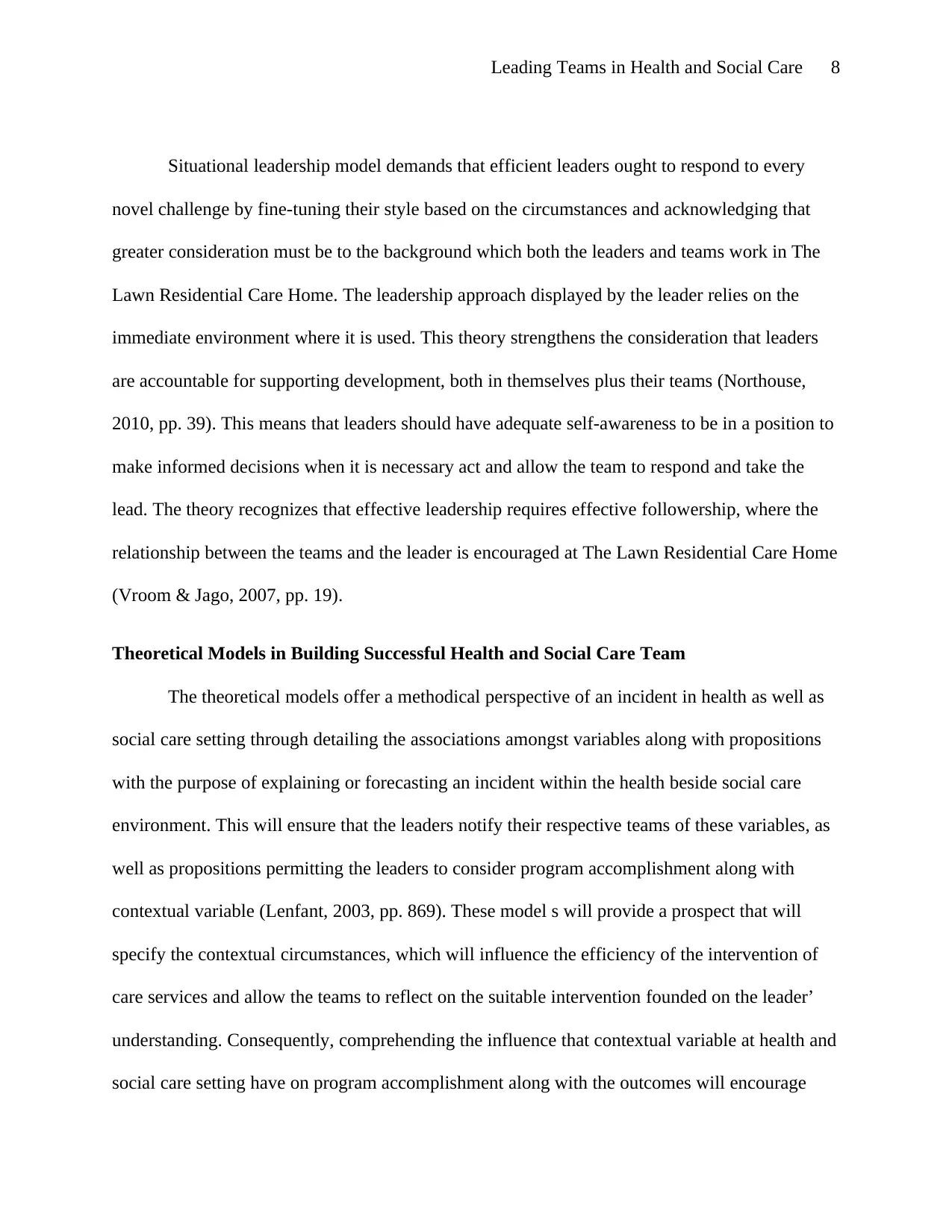
Leading Teams in Health and Social Care 8
Situational leadership model demands that efficient leaders ought to respond to every
novel challenge by fine-tuning their style based on the circumstances and acknowledging that
greater consideration must be to the background which both the leaders and teams work in The
Lawn Residential Care Home. The leadership approach displayed by the leader relies on the
immediate environment where it is used. This theory strengthens the consideration that leaders
are accountable for supporting development, both in themselves plus their teams (Northouse,
2010, pp. 39). This means that leaders should have adequate self-awareness to be in a position to
make informed decisions when it is necessary act and allow the team to respond and take the
lead. The theory recognizes that effective leadership requires effective followership, where the
relationship between the teams and the leader is encouraged at The Lawn Residential Care Home
(Vroom & Jago, 2007, pp. 19).
Theoretical Models in Building Successful Health and Social Care Team
The theoretical models offer a methodical perspective of an incident in health as well as
social care setting through detailing the associations amongst variables along with propositions
with the purpose of explaining or forecasting an incident within the health beside social care
environment. This will ensure that the leaders notify their respective teams of these variables, as
well as propositions permitting the leaders to consider program accomplishment along with
contextual variable (Lenfant, 2003, pp. 869). These model s will provide a prospect that will
specify the contextual circumstances, which will influence the efficiency of the intervention of
care services and allow the teams to reflect on the suitable intervention founded on the leader’
understanding. Consequently, comprehending the influence that contextual variable at health and
social care setting have on program accomplishment along with the outcomes will encourage
Situational leadership model demands that efficient leaders ought to respond to every
novel challenge by fine-tuning their style based on the circumstances and acknowledging that
greater consideration must be to the background which both the leaders and teams work in The
Lawn Residential Care Home. The leadership approach displayed by the leader relies on the
immediate environment where it is used. This theory strengthens the consideration that leaders
are accountable for supporting development, both in themselves plus their teams (Northouse,
2010, pp. 39). This means that leaders should have adequate self-awareness to be in a position to
make informed decisions when it is necessary act and allow the team to respond and take the
lead. The theory recognizes that effective leadership requires effective followership, where the
relationship between the teams and the leader is encouraged at The Lawn Residential Care Home
(Vroom & Jago, 2007, pp. 19).
Theoretical Models in Building Successful Health and Social Care Team
The theoretical models offer a methodical perspective of an incident in health as well as
social care setting through detailing the associations amongst variables along with propositions
with the purpose of explaining or forecasting an incident within the health beside social care
environment. This will ensure that the leaders notify their respective teams of these variables, as
well as propositions permitting the leaders to consider program accomplishment along with
contextual variable (Lenfant, 2003, pp. 869). These model s will provide a prospect that will
specify the contextual circumstances, which will influence the efficiency of the intervention of
care services and allow the teams to reflect on the suitable intervention founded on the leader’
understanding. Consequently, comprehending the influence that contextual variable at health and
social care setting have on program accomplishment along with the outcomes will encourage
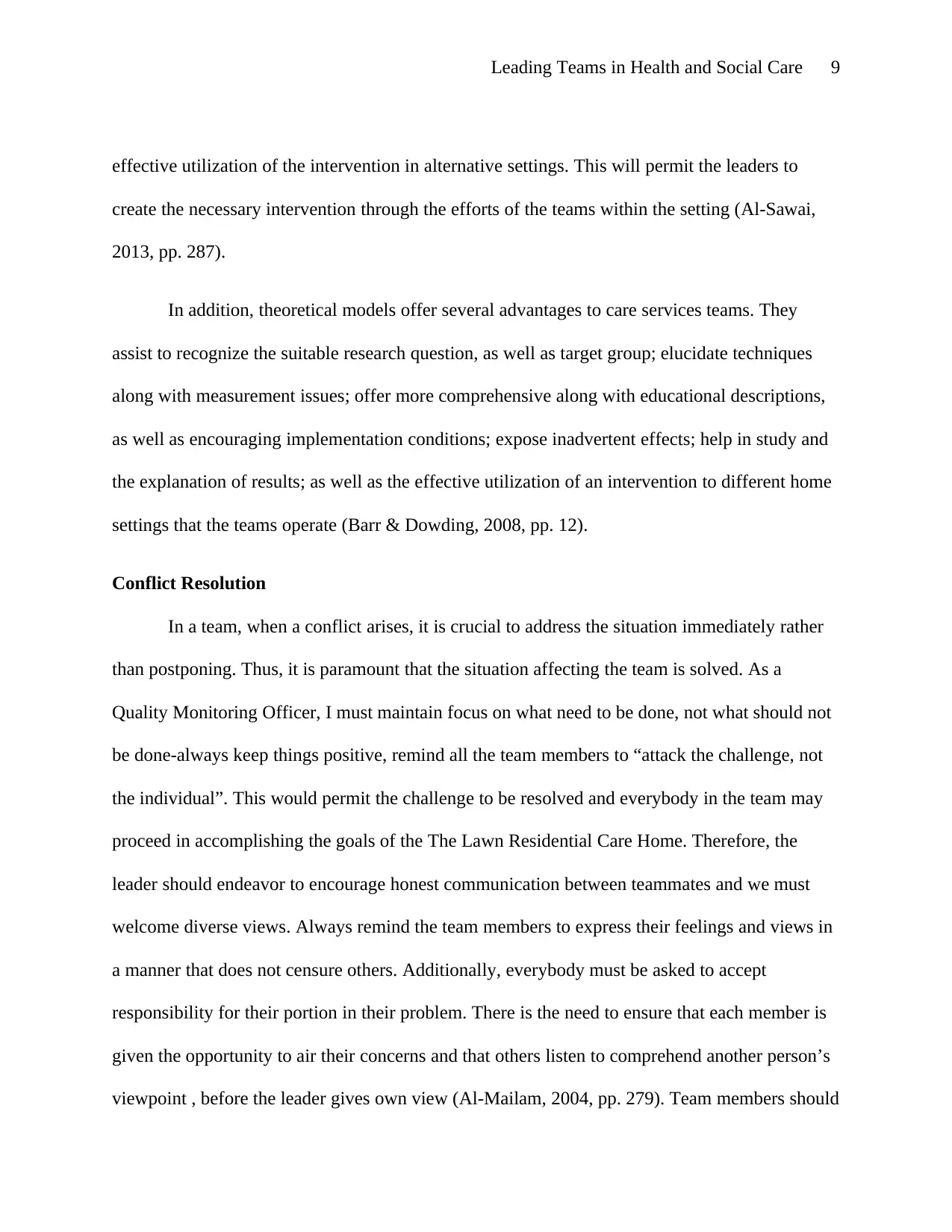
Leading Teams in Health and Social Care 9
effective utilization of the intervention in alternative settings. This will permit the leaders to
create the necessary intervention through the efforts of the teams within the setting (Al-Sawai,
2013, pp. 287).
In addition, theoretical models offer several advantages to care services teams. They
assist to recognize the suitable research question, as well as target group; elucidate techniques
along with measurement issues; offer more comprehensive along with educational descriptions,
as well as encouraging implementation conditions; expose inadvertent effects; help in study and
the explanation of results; as well as the effective utilization of an intervention to different home
settings that the teams operate (Barr & Dowding, 2008, pp. 12).
Conflict Resolution
In a team, when a conflict arises, it is crucial to address the situation immediately rather
than postponing. Thus, it is paramount that the situation affecting the team is solved. As a
Quality Monitoring Officer, I must maintain focus on what need to be done, not what should not
be done-always keep things positive, remind all the team members to “attack the challenge, not
the individual”. This would permit the challenge to be resolved and everybody in the team may
proceed in accomplishing the goals of the The Lawn Residential Care Home. Therefore, the
leader should endeavor to encourage honest communication between teammates and we must
welcome diverse views. Always remind the team members to express their feelings and views in
a manner that does not censure others. Additionally, everybody must be asked to accept
responsibility for their portion in their problem. There is the need to ensure that each member is
given the opportunity to air their concerns and that others listen to comprehend another person’s
viewpoint , before the leader gives own view (Al-Mailam, 2004, pp. 279). Team members should
effective utilization of the intervention in alternative settings. This will permit the leaders to
create the necessary intervention through the efforts of the teams within the setting (Al-Sawai,
2013, pp. 287).
In addition, theoretical models offer several advantages to care services teams. They
assist to recognize the suitable research question, as well as target group; elucidate techniques
along with measurement issues; offer more comprehensive along with educational descriptions,
as well as encouraging implementation conditions; expose inadvertent effects; help in study and
the explanation of results; as well as the effective utilization of an intervention to different home
settings that the teams operate (Barr & Dowding, 2008, pp. 12).
Conflict Resolution
In a team, when a conflict arises, it is crucial to address the situation immediately rather
than postponing. Thus, it is paramount that the situation affecting the team is solved. As a
Quality Monitoring Officer, I must maintain focus on what need to be done, not what should not
be done-always keep things positive, remind all the team members to “attack the challenge, not
the individual”. This would permit the challenge to be resolved and everybody in the team may
proceed in accomplishing the goals of the The Lawn Residential Care Home. Therefore, the
leader should endeavor to encourage honest communication between teammates and we must
welcome diverse views. Always remind the team members to express their feelings and views in
a manner that does not censure others. Additionally, everybody must be asked to accept
responsibility for their portion in their problem. There is the need to ensure that each member is
given the opportunity to air their concerns and that others listen to comprehend another person’s
viewpoint , before the leader gives own view (Al-Mailam, 2004, pp. 279). Team members should
⊘ This is a preview!⊘
Do you want full access?
Subscribe today to unlock all pages.

Trusted by 1+ million students worldwide
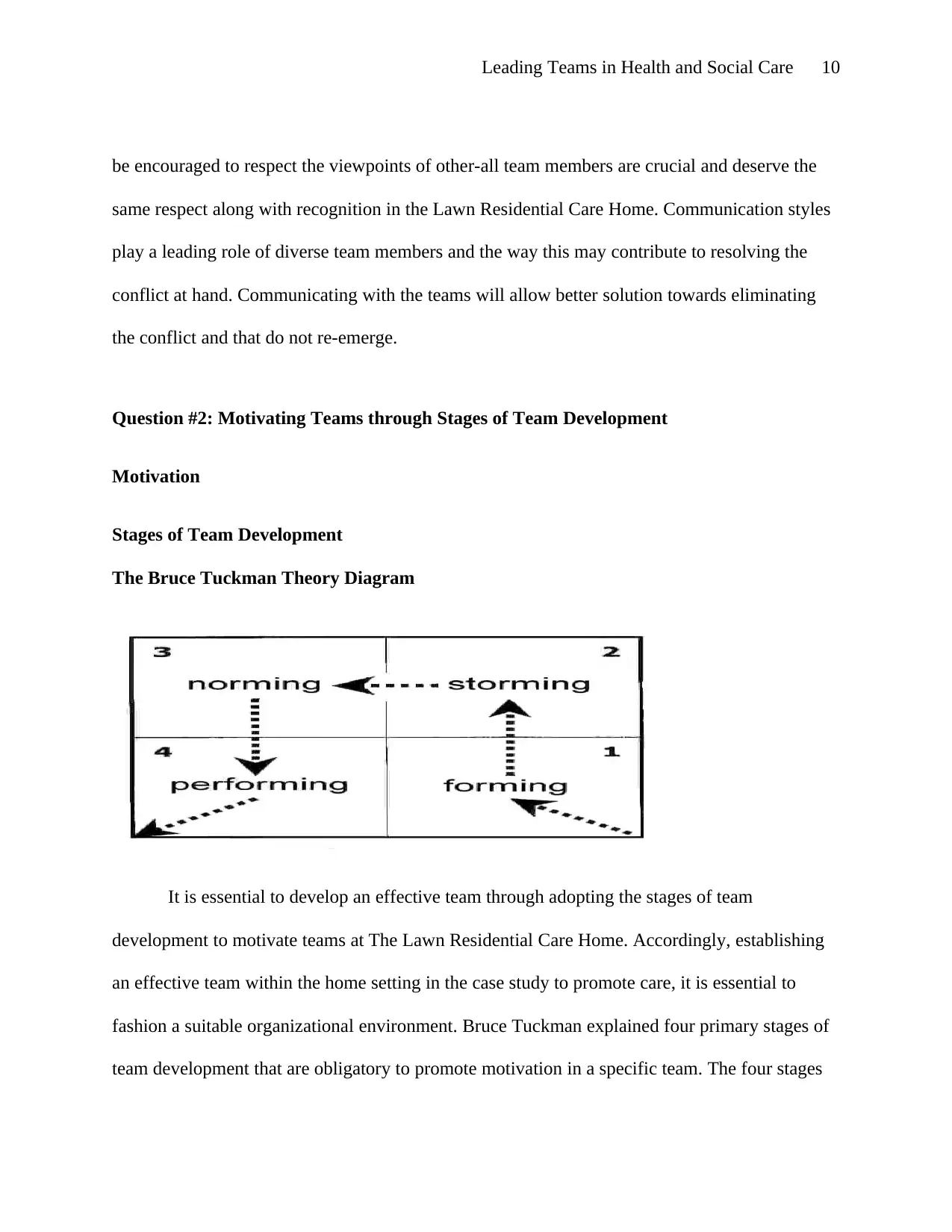
Leading Teams in Health and Social Care 10
be encouraged to respect the viewpoints of other-all team members are crucial and deserve the
same respect along with recognition in the Lawn Residential Care Home. Communication styles
play a leading role of diverse team members and the way this may contribute to resolving the
conflict at hand. Communicating with the teams will allow better solution towards eliminating
the conflict and that do not re-emerge.
Question #2: Motivating Teams through Stages of Team Development
Motivation
Stages of Team Development
The Bruce Tuckman Theory Diagram
It is essential to develop an effective team through adopting the stages of team
development to motivate teams at The Lawn Residential Care Home. Accordingly, establishing
an effective team within the home setting in the case study to promote care, it is essential to
fashion a suitable organizational environment. Bruce Tuckman explained four primary stages of
team development that are obligatory to promote motivation in a specific team. The four stages
be encouraged to respect the viewpoints of other-all team members are crucial and deserve the
same respect along with recognition in the Lawn Residential Care Home. Communication styles
play a leading role of diverse team members and the way this may contribute to resolving the
conflict at hand. Communicating with the teams will allow better solution towards eliminating
the conflict and that do not re-emerge.
Question #2: Motivating Teams through Stages of Team Development
Motivation
Stages of Team Development
The Bruce Tuckman Theory Diagram
It is essential to develop an effective team through adopting the stages of team
development to motivate teams at The Lawn Residential Care Home. Accordingly, establishing
an effective team within the home setting in the case study to promote care, it is essential to
fashion a suitable organizational environment. Bruce Tuckman explained four primary stages of
team development that are obligatory to promote motivation in a specific team. The four stages
Paraphrase This Document
Need a fresh take? Get an instant paraphrase of this document with our AI Paraphraser
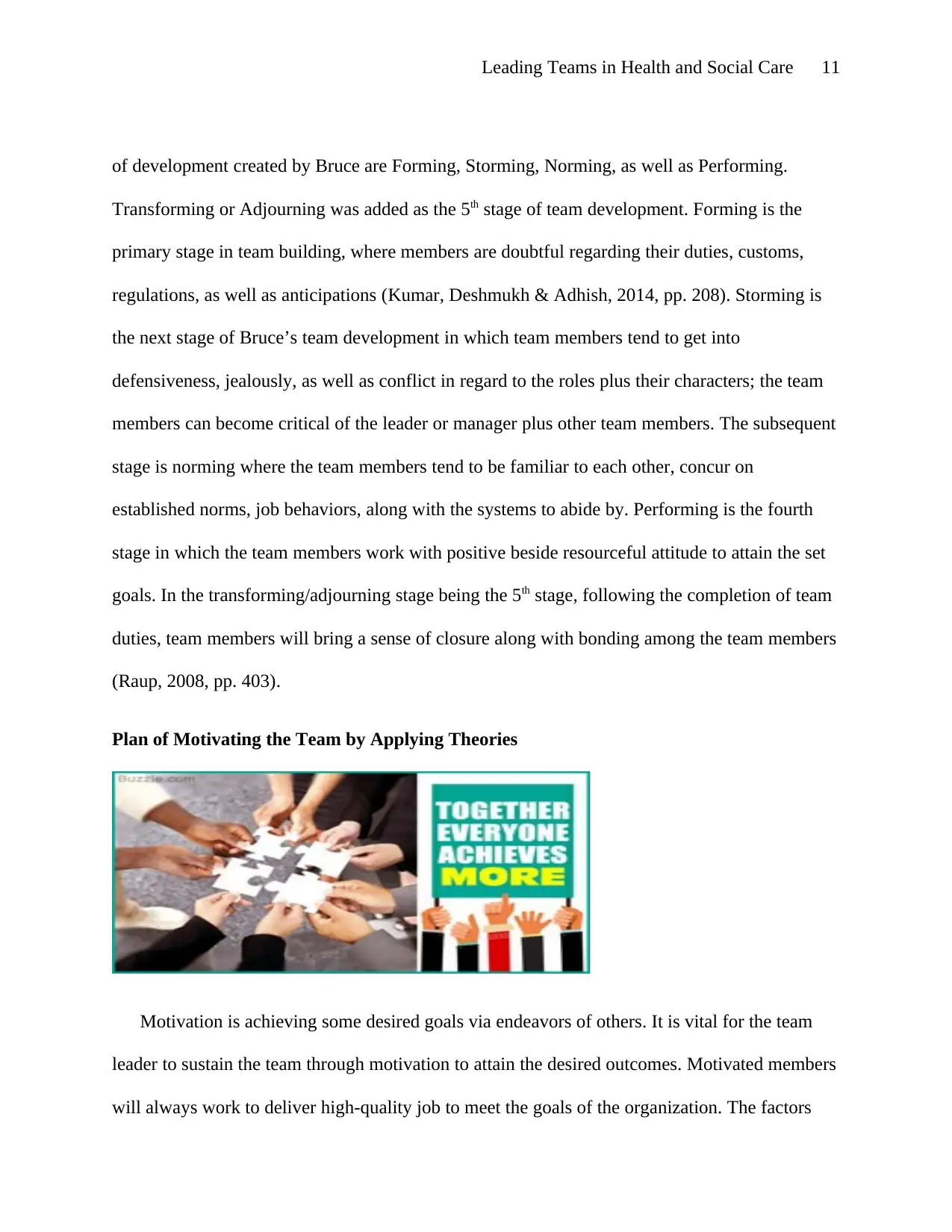
Leading Teams in Health and Social Care 11
of development created by Bruce are Forming, Storming, Norming, as well as Performing.
Transforming or Adjourning was added as the 5th stage of team development. Forming is the
primary stage in team building, where members are doubtful regarding their duties, customs,
regulations, as well as anticipations (Kumar, Deshmukh & Adhish, 2014, pp. 208). Storming is
the next stage of Bruce’s team development in which team members tend to get into
defensiveness, jealously, as well as conflict in regard to the roles plus their characters; the team
members can become critical of the leader or manager plus other team members. The subsequent
stage is norming where the team members tend to be familiar to each other, concur on
established norms, job behaviors, along with the systems to abide by. Performing is the fourth
stage in which the team members work with positive beside resourceful attitude to attain the set
goals. In the transforming/adjourning stage being the 5th stage, following the completion of team
duties, team members will bring a sense of closure along with bonding among the team members
(Raup, 2008, pp. 403).
Plan of Motivating the Team by Applying Theories
Motivation is achieving some desired goals via endeavors of others. It is vital for the team
leader to sustain the team through motivation to attain the desired outcomes. Motivated members
will always work to deliver high-quality job to meet the goals of the organization. The factors
of development created by Bruce are Forming, Storming, Norming, as well as Performing.
Transforming or Adjourning was added as the 5th stage of team development. Forming is the
primary stage in team building, where members are doubtful regarding their duties, customs,
regulations, as well as anticipations (Kumar, Deshmukh & Adhish, 2014, pp. 208). Storming is
the next stage of Bruce’s team development in which team members tend to get into
defensiveness, jealously, as well as conflict in regard to the roles plus their characters; the team
members can become critical of the leader or manager plus other team members. The subsequent
stage is norming where the team members tend to be familiar to each other, concur on
established norms, job behaviors, along with the systems to abide by. Performing is the fourth
stage in which the team members work with positive beside resourceful attitude to attain the set
goals. In the transforming/adjourning stage being the 5th stage, following the completion of team
duties, team members will bring a sense of closure along with bonding among the team members
(Raup, 2008, pp. 403).
Plan of Motivating the Team by Applying Theories
Motivation is achieving some desired goals via endeavors of others. It is vital for the team
leader to sustain the team through motivation to attain the desired outcomes. Motivated members
will always work to deliver high-quality job to meet the goals of the organization. The factors
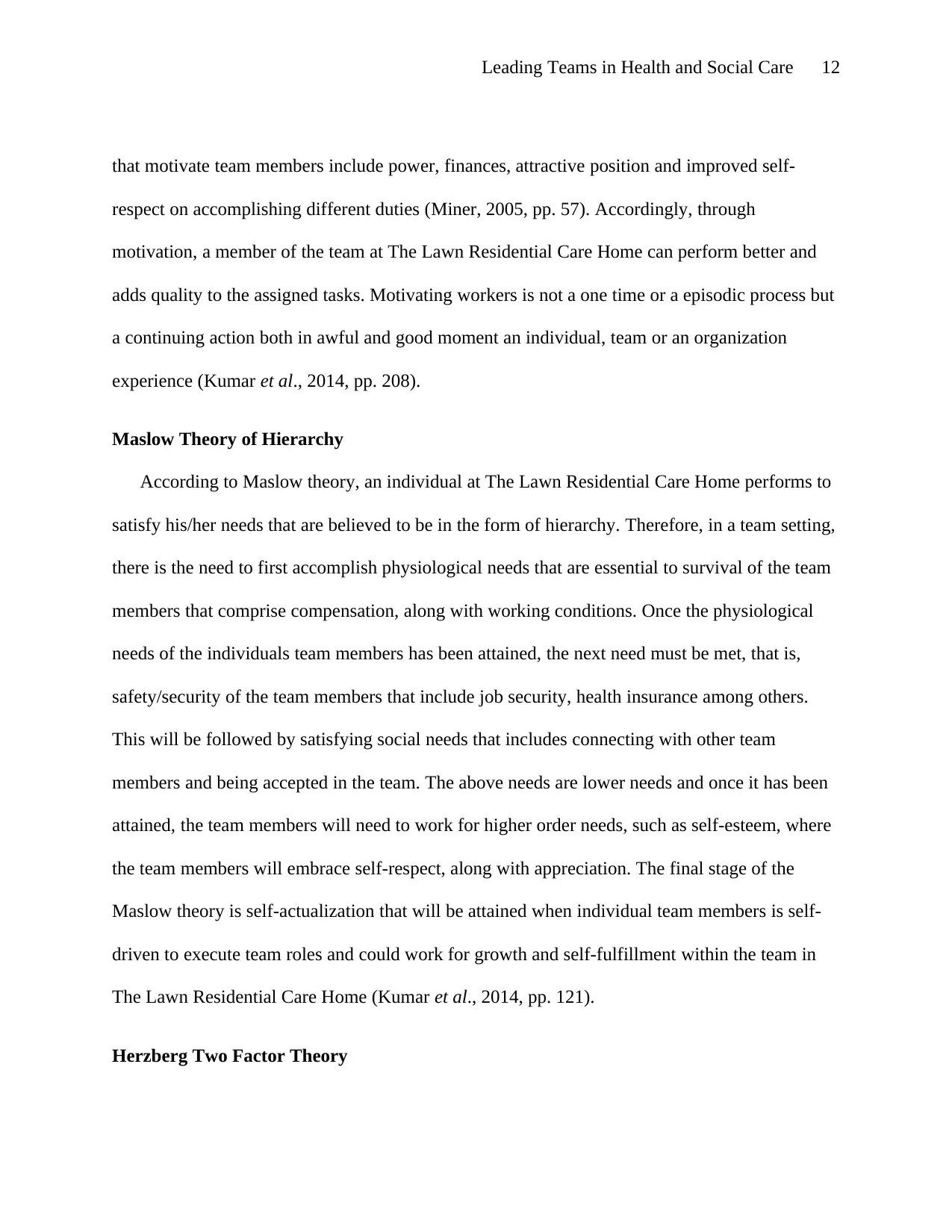
Leading Teams in Health and Social Care 12
that motivate team members include power, finances, attractive position and improved self-
respect on accomplishing different duties (Miner, 2005, pp. 57). Accordingly, through
motivation, a member of the team at The Lawn Residential Care Home can perform better and
adds quality to the assigned tasks. Motivating workers is not a one time or a episodic process but
a continuing action both in awful and good moment an individual, team or an organization
experience (Kumar et al., 2014, pp. 208).
Maslow Theory of Hierarchy
According to Maslow theory, an individual at The Lawn Residential Care Home performs to
satisfy his/her needs that are believed to be in the form of hierarchy. Therefore, in a team setting,
there is the need to first accomplish physiological needs that are essential to survival of the team
members that comprise compensation, along with working conditions. Once the physiological
needs of the individuals team members has been attained, the next need must be met, that is,
safety/security of the team members that include job security, health insurance among others.
This will be followed by satisfying social needs that includes connecting with other team
members and being accepted in the team. The above needs are lower needs and once it has been
attained, the team members will need to work for higher order needs, such as self-esteem, where
the team members will embrace self-respect, along with appreciation. The final stage of the
Maslow theory is self-actualization that will be attained when individual team members is self-
driven to execute team roles and could work for growth and self-fulfillment within the team in
The Lawn Residential Care Home (Kumar et al., 2014, pp. 121).
Herzberg Two Factor Theory
that motivate team members include power, finances, attractive position and improved self-
respect on accomplishing different duties (Miner, 2005, pp. 57). Accordingly, through
motivation, a member of the team at The Lawn Residential Care Home can perform better and
adds quality to the assigned tasks. Motivating workers is not a one time or a episodic process but
a continuing action both in awful and good moment an individual, team or an organization
experience (Kumar et al., 2014, pp. 208).
Maslow Theory of Hierarchy
According to Maslow theory, an individual at The Lawn Residential Care Home performs to
satisfy his/her needs that are believed to be in the form of hierarchy. Therefore, in a team setting,
there is the need to first accomplish physiological needs that are essential to survival of the team
members that comprise compensation, along with working conditions. Once the physiological
needs of the individuals team members has been attained, the next need must be met, that is,
safety/security of the team members that include job security, health insurance among others.
This will be followed by satisfying social needs that includes connecting with other team
members and being accepted in the team. The above needs are lower needs and once it has been
attained, the team members will need to work for higher order needs, such as self-esteem, where
the team members will embrace self-respect, along with appreciation. The final stage of the
Maslow theory is self-actualization that will be attained when individual team members is self-
driven to execute team roles and could work for growth and self-fulfillment within the team in
The Lawn Residential Care Home (Kumar et al., 2014, pp. 121).
Herzberg Two Factor Theory
⊘ This is a preview!⊘
Do you want full access?
Subscribe today to unlock all pages.

Trusted by 1+ million students worldwide
1 out of 22
Your All-in-One AI-Powered Toolkit for Academic Success.
+13062052269
info@desklib.com
Available 24*7 on WhatsApp / Email
![[object Object]](/_next/static/media/star-bottom.7253800d.svg)
Unlock your academic potential
Copyright © 2020–2025 A2Z Services. All Rights Reserved. Developed and managed by ZUCOL.